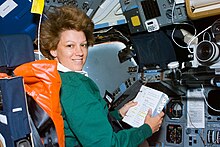STS-93
 | |
| Dane misji | |
| Indeks COSPAR | 1999-040A |
|---|---|
| Zaangażowani | |
| Oznaczenie kodowe | STS-93 |
| Pojazd | |
| Wahadłowiec | Columbia |
| Załoga | |
 Od lewej: Eileen Collins, Steven Hawley, Jeffrey Ashby, Michel Tognini i Catherine Coleman. | |
| Dowódca | Eileen Collins |
| Start | |
| Miejsce startu | Stany Zjednoczone, KSC, LC39-B |
| Początek misji | 23 lipca 1999 04:31:00 UTC |
| Orbita okołoziemska | |
| Apogeum | 280 km |
| Perygeum | 260 km |
| Okres orbitalny | 89,9 min |
| Inklinacja orbity | 28,5° |
| Lądowanie | |
| Miejsce lądowania | KSC, Pas startowy 33 |
| Lądowanie | 28 lipca 1999 03:20:35 UTC[1][2] |
| Czas trwania misji | 4 dni, 22 godziny, 49 minut i 35 sekund[1][2] |
| Przebyta odległość | 2,89 mln km[1] |
| Liczba okrążeń Ziemi | 80[1] |
| Program lotów wahadłowców | |

STS-93 – dwudziesta szósta misja amerykańskiego wahadłowca kosmicznego Columbia, na pokładzie którego na orbitę wyniesiony został kosmiczny teleskop Chandra. Po raz pierwszy dowódcą misji była kobieta – Eileen Marie Collins. Był to dziewięćdziesiąty piąty lot programu lotów wahadłowców[3].
Załoga
- źródło[3]
- Eileen M. Collins (3)*, dowódca (CDR)
- Jeffrey S. Ashby (1), pilot (PLT)
- Steven Hawley (5), specjalista misji (MS2)
- Catherine G. "Cady" Coleman (2), specjalista misji (MS1)
- Michel Tognini (CNES) (2), specjalista misji (MS3) (Francja)
- *(w nawiasie podano liczbę lotów odbytych przez każdego z astronautów)
Parametry misji
- Masa:
- startowa orbitera: 122 536 kg
- lądującego orbitera: 99 783 kg
- ładunku: 22 781 kg
- Perygeum: 260 km[4]
- Apogeum: 280 km[4]
- Inklinacja: 28,5°[4]
- Okres orbitalny: 89,9 min[4]
Cel misji
Umieszczenie na orbicie obserwatorium rentgenowskiego Chandra (Chandrasekhar X-Ray Observatory)[3].
Zobacz też
Przypisy
- ↑ a b c d podsumowanie misji STS-93 na stronie KSC (ang.)
- ↑ a b Adam Chen, William Wallack, George Gonzales: Celebrating 30 Years of the Space Shuttle program. NASA, 2012. ISBN 978-0-16-090202-4.
- ↑ a b c Tomáš Přibyl: Dzień, w którym nie wróciła COLUMBIA. Bielsko-Biała: Wydawnictwo >DEBIT<, 2003, s. 174. ISBN 83-7167-224-1.
- ↑ a b c d * Mark Wade: STS-93 (ang.). W: Encyclopedia Astronautica [on-line]. [dostęp 2017-07-27].
Linki zewnętrzne
- podsumowanie misji STS-93 na stronie KSC (ang.)
- Mark Wade: STS-93 (ang.). W: Encyclopedia Astronautica [on-line]. [dostęp 2017-07-27].
- Spaceflight mission report: STS-93 (ang.). Spacefacts. [dostęp 2017-07-27].
Media użyte na tej stronie
The flag of Navassa Island is simply the United States flag. It does not have a "local" flag or "unofficial" flag; it is an uninhabited island. The version with a profile view was based on Flags of the World and as a fictional design has no status warranting a place on any Wiki. It was made up by a random person with no connection to the island, it has never flown on the island, and it has never received any sort of recognition or validation by any authority. The person quoted on that page has no authority to bestow a flag, "unofficial" or otherwise, on the island.
Astronaut Eileen M. Collins, mission commander, looks over a procedures checklist at the commander's station on the forward flight deck of the Space Shuttle Columbia on Flight Day 1. The most important event of this day was the deployment of the Chandra X-Ray Observatory, the world's most powerful X-Ray telescope. The photo was recorded with an electronic still camera (ESC). S93-E-5033.
The five astronauts assigned to fly aboard the Space Shuttle Columbia early next year for the STS-93 mission pose with a small model of their primary payload-the Advanced X-ray Astrophysics Facility (AXAF). Collins, mission commander; Steven A. Hawley, mission specialist; Jeffrey S. Ashby, pilot; Michel Tognini and Catherine G. Coleman, both mission specialists. Tognini represents France's Centre National d'Études Spatiales (CNES). The scheduled five-day mission will feature the deployment of AXAF, which will enable scientists to conduct comprehensive studies of exotic phenomena in the universe. Among bodies studied will be exploding stars, quasars and black holes.
STS093 (S)-001 (Sept. 1998) --- The STS-93 mission patch, as designed by the five crew members. The STS-93 mission will carry the Advanced X-ray Astrophysics Facility (AXAF) into low Earth orbit initiating its planned five-year astronomy mission. AXAF is the third of NASA's great observatories, following the Hubble Space Telescope and the Compton Gamma Ray Observatory. AXAF will provide scientists an order-of-magnitude improvement over current capabilities at X-ray wavelengths. Observations of X-ray emissions from energetic galaxies and clusters, as well as black holes, promise to greatly expand current understanding of the origin and evolution of our universe. The STS-93 patch depicts AXAF separating from the Space Shuttle Columbia after a successful deployment. A spiral galaxy is shown in the background as a possible target for AXAF observations. The two flags represent the international crew, consisting of astronauts from both the United States and France. The NASA insignia design for Shuttle flights is reserved for use by the astronauts and for other official use as the NASA Administrator may authorize. Public availability has been approved only in the form of illustrations by the various news media. When and if there is any change in this policy, which we do not anticipate, it will be publicly announced.



